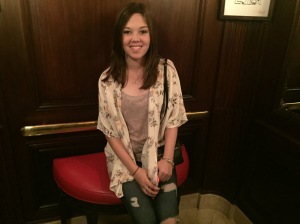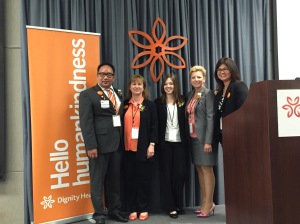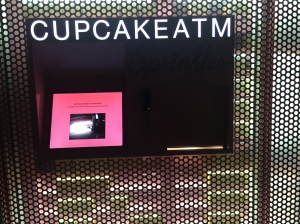I was interviewed by Danny van Leeuwen for his Health Hats blog. I wanted to share the interview here. Thanks Danny for interviewing me about my thoughts on transitioning to adult healthcare, on how to change healthcare, and my thoughts on advocating for myself and others! It was fun.
No Wonder Healthcare Is So Expensive!
I am thinking that we might really need to just burn the healthcare system to the ground and completely start over.
Although I am pretty experienced with healthcare, the financial piece is one that I haven’t really been as involved in since I am still on my parent’s insurance and they pay the bills. Knowing that I can’t do that forever, I have been starting to pay more attention. Last weekend, I was home in Tampa, and my mom was muttering something about our new insurance and the bill. So, I decided to take the opportunity to learn more. I don’t know if others know how this all works, but I didn’t, so I am going to explain what I learned. Brace yourselves. It’s ridiculous.
Due to my rare disease, I get two infusions in the hospital each month. I am admitted to the hospital for about 23 hours. It is the same treatment every single month. Exactly the same. Every once in a while I might need more meds for nausea or an extra lab test or something minor, but essentially it is always exactly the same.
Hospitals (and doctors in general) create this thing called a Chargemaster that has the rate for every procedure or group of procedures that they bill insurance companies and self-pay patients. Medicare has standard rates for all procedures, however those rates get increased in some areas because they are more expensive areas, such as New York or San Francisco. However, these rates are all based on a base payment and just adjusted for the city. But, the hospital knows that some insurance companies will pay more than others and they don’t want to limit their payment if someone will pay more, so they jack up the rate that they bill for everyone. So, let’s say Medicare will pay $100 for something like a Chest X-Ray. Well, Cigna might pay $150, Blue Cross might pay $135, Aetna might pay $200, and some insurance company that they don’t have a contract with might pay $300. So, the hospital makes the rate something like $700 to be absolutely sure that they charge more than the highest possible amount someone might pay. Then, they write off the $500 difference between the $700 and the $200 for Aetna, and the $400 for the insurance company that they don’t have a contract with. The self-pay patient has to negotiate with the hospital, and hopefully they get a rate at least 25 -50% of the $700. But there is no requirement for the hospital to have a self-pay rate that is any specific rate.
So, what freaked my mom and I out this weekend is the difference that my hospital was paid for the EXACT same medications, with the EXACT same doctor, at the EXACT same hospital with the EXACT same nurses. I have had three insurance companies in the last 12 months. The pictures and table below show what they have paid at the same hospital and treatment.
| Insurance Company | Rate Charged | Amount Written Off | Amount the Hospital Received |
| GEHA (Aetna Contract) | $28,405.99 | $7,669.62 | $20,736.37* |
| Blue Cross Alabama | $29,756.15 | $25,930.71 | $3,827.45 |
| Cigna | $28,755.17 | $25,436.17 | $3,319.00** |
*$4,260.90 was what I (the patient) had to pay ** $221.82 was what I had to pay
The difference in cost to the system is $202,907.04 a year just for me!
I understand the value of having negotiated rates, and I get that insurance companies can argue that they bring patients or offer some other competitive reason for the hospital to give them a discount. BCBS and Cigna were fairly close with about $500 difference or 13%. However, I cannot possibly imagine how one insurance company has to pay 5.41 times more for the exact same thing! Literally over $16,000 more!!
So after all this you might be wondering how why does this really matter to me if it only makes the insurance companies pay more in some cases? This is actually one of the biggest causes of heath care being so expensive because the insurance company paying more means that your family will need to pay more in premiums and in out of pocket expenses. NO WONDER HEALTH CARE IS SO EXPENSIVE.
But wait… there’s more.
So, I asked my mom to get me some more examples. My dad started searching through the millions of Explanation of Benefit or EOB files we have (by the way, why are these still sent by paper??). These EOB reports are what explain this whole system of what was billed, what is allowed by the insurance company contract, what the insurance company is paying, and how much the patient owes.
Over the years, I have had this exact same treatment now at three different hospitals and with multiple different insurance companies. I wanted to see how much these vary. These additional ones are shown in pictures and the table below.
| Hospital | Insurance Company | Rate Charged | Amount Written Off | Amount the Hospital Received |
| EAMC | GEHA (Aetna Contract) | $28,405.99 | $7,669.62 | $20,736.37* |
| EAMC | Blue Cross Alabama | $29,756.15 | $25,930.71 | $3,827.45 |
| EAMC | Cigna | $28,755.17 | $25,436.17 | $3,319.00** |
| FHWC | Cigna | $47,171.56 | $29,435.05 | $17,736.51 |
| ACH | Cigna | $19,491 | $9745.98 | $9745.95 |
| ACH | Blue Cross North Carolina | $18,279 | $8,832.23 | $9,447.79 |
I know it is a lot of numbers, and it has been mind-blowing to me. So, just to make sure we are all on the same page.
- I had the exact same Cigna plan for three different hospitals. The charges for the same infusion at the three hospitals were $28,755, $47,171, and 19,491. I never knew that it was that different.
- The reimbursement from the SAME insurance company for three different hospitals was $3,319, $17,736, and $9,745. I never knew that picking a different hospital could make THAT much of a difference. In fact, the cheapest one is where I have felt I have gotten the best care, had the best nurses, and had the least amount of complications.
- The reimbursements overall ranged from $3,319 to $20,736. How is that possible? Why do we allow this?
- Two different Blue Cross Plans paid drastically different amounts – $3,827 to $9,447. I would have thought they would be similar since they are both Blue Cross?
The thing that has me wondering the most is how can we help patients understand this? How can we choose hospitals that have the best rate AND the great quality? In my case, I think the lowest price is actually also the best quality, but it could have been that the lowest reimbursement was lower quality. How can we help people evaluate this? How can we get the difference in fees to be lower? Maybe everyone should post their bills? Can we require hospitals or insurance companies to publish their rates?
I have seen on twitter that hospitals had to post their prices. I went looking at these three hospitals but I couldn’t figure out the charges. Even if I had, I would have thought All Children’s (ACH) was the best deal because it had the lowest actual charge, but the reimbursement rates in their contracts were actually higher.
I am starting to understand the basics of why the financials of our healthcare system are such a mess. I have focused on improving the patient experience, keeping patients safe, and improving treatment options that are available. I guess now I need to learn more about the financial aspect of health care. And just from researching this in one day, I can already tell that it is just as messed up as the rest of the health care system.
I wish there was an easy to use app that would let me compare prices and quality so that I could easily make a decision on where to go. Instead, I have to attempt to decipher what the vague numbers on the hospitals website actually mean and try to guess which insurance company pays the best rate to the hospital. Surely we can do better. We must do better.
I am sure there is a lot I don’t know. Please share comments!
Medical Record Errors
Because I am an engaged patient, I find errors in my medical records fairly often. Usually, they are minor issues and I wonder if it is worth raising it to the doctor because it probably won’t make a difference in the long run. For example, I have seen that they marked me as male in a note or it mentioned my pain was in my lower back instead of my upper back.
Other issues, however, are more significant. Several years ago, a doctor accidentally marked Diabetes on an MRI order form, and somehow that added the problem to my health condition list. When that specialist sent the notes to my primary doctor and my rheumatologist, then they added Diabetes to my health conditions and suddenly people were asking me what my glucose levels were. They seemed very concerned when I told them I had no idea!
My most recent example was both shocking, and the response I received was a troubling reminder of how the healthcare system sees patient input. First, for those who don’t know me, I am 19 years old and in college. I have never been pregnant, and I have no children.
So, you can imagine my surprise when I saw this in my medical record…

You can imagine that I was not pleased to see that, especially since it had already been sent to two other doctors. Who knew that I had a child at 13? Apparently that imaginary child didn’t survive though, but somehow imaginary pregnancy 2 was able to survive.
I understand that mistakes happen, and it is very easy for the doctor to accidentally mix up two patients or accidentally click the wrong options in their very, very click-intensive EMR. However, I was not pleased with the response when I had my health assistant at CareSync try to get the record corrected for me.
The office staff said that “the patient must have told us that if it is in the record.”
They also would not take my health assistant’s correction, despite the fact that the history was only incorrect in one visit and in the month prior it said I had zero pregnancies and zero children.
In order for me to get it corrected, I had to submit the request in writing. They then also called me to confirm. 14 days later, I received a corrected copy in the mail – despite me asking in the written form if they could email it to me (and acknowledged that it is not secure).
How do we reduce the chance for errors in EMR systems? Simple documentation errors can cause major medical errors when someone else reviews the documentation as a source of truth (often believing that over what the patient says because “it must have been so because it was documented in the EMR)
How do we make it easier to get errors corrected? I wonder how many patients even know that they can get errors corrected.
Have you had experiences with errors? I would love to hear your stories.
Update on me
It has been a while since i have written in my blog! I have been busy trying to manage college life, and while I constantly have ideas to write about, I struggle to find time to get them down on paper. My resolution for 2018 is to blog at least once a month going forward. Help me stay on target if I start slacking 🙂
An update on me…
I am in my second year at Auburn University, and I am really enjoying my time in college. I could graduate in December with my Bachelor’s in Psychology, but I am planning to double major either in Health Administration or Communications. I set out to major in Health Administration, but I didn’t enjoy the intro class at all which has made me second guess that. I really want to work in the patient experience field, and there really isn’t a great degree that matches up with that other than nursing or healthcare administration. I felt that psychology would be helpful in understanding how to drive behavior change in the healthcare system and in the people who work in the system and the patients who use it. Communications may also be helpful in that realm. Healthcare administration would be good to have a more solid foundation of the system in general, but I can probably accomplish that with a minor. If anyone has suggestions outside of these majors, I would be interested in hearing the ideas and your perspective. Even though I can graduate in December, I am in no hurry and plan to use my 4 years to get an education. I was lucky enough to be featured in the Auburn Student Spotlight last summer.
I am continuing to speak at conferences and health systems, and I love being able to participate in patient experience work happening at health systems or practices.
If you have need for a speaker or a consultant, I would love to hear from you!
As for my health, I am continuing to fight the fight against Juvenile Dermatomyositis and the overlapping issues of Juvenile Idiopathic Arthritis and Ulcerative Colitis. I still get admitted to the hospital once a month for my 16 hour infusion of IVIG and my infusion of Solumedrol. I added Humira to my regimen last fall with the hopes of knocking at all three issues so that I could get off of some of the 21 pills I take daily.
I transitioned to college pretty well from a medical perspective, and I am very, very, very fortunate to have found a wonderful rheumatologist, Dr. Charles Adams. If you live in the Auburn/Opelika area, I highly recommend him. He is very patient-centered and understands the challenges of being a patient who is trying to live and manage a chronic disease. I have been struggling with the GI issues, and I have found getting answers to those issues more challenging than my rare disease. I am not sure why, but it seems to be a “wait and see” speciality. Although these issues have a profound impact on my life and ability to function, they just don’t seem to be that urgent to the GI doctor. There aren’t many in the area, so I will continue to push for answers.
I do struggle to keep up with classwork and the social aspects of college. I know I miss out on a lot of activities because i know that if I go that I will suffer from being too active. I have had significant issues each semester, and I am thankful that professors (minus a rare few) are willing to work with me on making up assignments when I have to miss them. Overall, i have managed pretty well.
By the way, WAR EAGLE to all you Auburn people out there. We won the Iron Bowl in football, and it looks like we might have a nice run in basketball too.
I will do my best to at least get a post up monthly, and I would love to hear from you!
Family Centered Rounds – Published!
Life has been so busy that I didn’t even realize my first official published article was posted! I was asked to review a published study about family centered rounds for the Hospital Pediatrics journal. My original pediatric hospital did some form of family centered rounds even when I was diagnosed in 2010, so I haven’t really known the healthcare world without it. I have found some benefits and some frustrations with it, so I was very interested in the study found here.
The results published were very interesting.
“RESULTS: Thirty rounding sessions involving 234 encounters of FCR over a 12-week period were analyzed. On average, teams spent 7 minutes in each patient room and approximately the same amount of time outside of the room. Attending physicians were the dominant medical speakers during rounds (30.8%), and nurses spoke the least (2%). When inside a patient room, there was no significant difference between the percentage of time that attending physicians spoke (25.6%) and that of families and patients (23.0%). The surveys revealed that the medical team consistently underestimated the percentage of time attending physicians talked and desired attending physicians to talk less. They also overestimated the time spent in the patient rooms, the time families talked, and nurse presence during rounds and desired an increase in each of these areas.” Pickel et al
The best part was in the Conclusion:
“Medical teams believe and desire that attending physicians talk less and families and nurses talk more than observations reveal.” Pickel et al
My discussion article that was also published in Hospital Pediatrics can be found here.
I obviously am all for more collaboration with patients, and I highlighted that in my conclusion. I am excited to see this type of study taking place.
“One example that would be great is having a truly patient-centered rounding system to evaluate whether it is possible to include all providers and family in rounds at 1 time and then assess whether it makes a significant difference in patient experience or outcomes. We would also like to see a study examining whether waking patients up early for rounds affects their participation and outcomes compared with letting them wake up naturally. Another valuable study would be to evaluate the perceptions of the patient on the rounding process compared with the perceptions of the providers and nurses on discharge. This study provides a great model for additional understanding, and we hope to see more like it in the future.” – Morgan Gleason and Amy Gleason
How would you like to see collaboration and family rounding happen?
Transition to Adult Care

Hey guys! I have officially been at Auburn University for a month, and man has it been a busy one (War eagle!). College is fun, exciting, and scary all at one time. You are meeting so many new people, while trying to figure out who you are and where you fit in. You are trying to balance your social life and make good grades at the same time. All of this is what a normal college student is going through. In my situation, I also have to balance my health on top of all this. While I’m still trying to figure out what this all means, I have a basic feel for what that entails. It is both strange and difficult to be solely responsible for your own healthcare.
I have always been more involved with my healthcare than your average teen. However, I have also always had my mom there to help me out. In my month and a half of being at college, I have gotten my infusion at the local adult hospital here.
Since I was diagnosed when I was 11, I have always gone to the same pediatric hospital and seen the same doctors and nurses who know everything there is to know about my health. Moving to a new state and having to go see a new rheumatologist where I don’t have the close relationship I had with my old one is tough. On top of that, I transitioned to adult care because now I am a legal adult as of August 24th. It also meant that I needed to go to my first adult doctor by myself, to meet my new rheumatologist on the day after my 18th birthday. The majority of pediatric doctors are very nurturing and are extra compassionate, as you have to be with kids. Adult doctors seem to be much more rigid.
However, there are pros and cons to pediatrics and adult medicine. The adult doctor that I have seen here is clearly much more used to involving his patients directly, rather than their parents or caregiver. He talked to me like I had something to say, and more like I was his equal. This could’ve been because I was very confident in telling him what I needed and what normally goes on with me during my infusions, but he seemed very understanding. He had to learn my entire very complex protocol for my IVIG. He had to learn everything about my long health history in just about an hour. After that appointment, which went very well, actually much better than I had expected, I was admitted to the hospital for my infusion. This also went very well, and I had no major drama which was fantastic. I was quite surprised because I had expected the nurses to be different somehow, but all of them were awesome and very nice.
Being in a new place for my infusion was a strange experience. One of the few complaints I had involved the food. My old pediatric hospital has a room service system. You call down and order exactly what you want and when you want it, and they bring it up to you in less than 45 mins. I guess I was somewhat pampered because of this :). This adult hospital had a schedule. They bring you breakfast at 7:30 whether you are awake and hungry or not, and they give you no choice on what they bring. You don’t like soggy mush in a bowl? Oh, too bad, that’s the only option. It’s the same thing with lunch and dinner. So, because I am a very selective eater due to my ulcerative colitis, I didn’t eat a single thing they served while I was there. I can’t have a lot of things because they upset my stomach, and I am not very willing to try new kinds of food in case they make me feel badly. I did ask my mom to get cereal the second morning when the downstairs cafeteria was open (which isn’t for very long and that was also strange to have such limited hours for the cafeteria).
I did have a couple of other concerns involving having two doctors with different ideas, a hospitalist and my rheumatologist, and I did have a strange experience about my potassium levels. However, that’s a whole other post.
The more that I am in hospitals, I realize that a lot of ideas sound better in words than in actual actions. I am guessing that they are created to bring up scores that are measured and displayed like this.

This new hospital has a policy of giving every patient that is discharged a paper red folder with your medications, diagnoses and allergies. They require you to walk out the door with the red folder, no matter what the circumstances are. I have been going to get these same medications by infusion for 6 and a half years, and I am very confident that I know everything there is to know about what meds I’m on and my diagnosis. I do not need a red folder to inform me about this, especially because I am the one who informed the hospital about my medication list in the first place. When you are admitted, they ask you what medications you are on, and I provided them with this information. I definitely don’t need a physical folder to tell me about this.
I could tell the makers of the red folder more about how to handle my personal health than they could. I personally find it extremely pointless and ridiculous to make every single person walk out the door with a physical copy of a folder. We live in a technology based world. Every single person, with very few outliers, has a smart phone or a computer. We have access to technology, where information is very easily accessible. Why are we not providing people with their health information online in a format that they will always have with them? And I don’t mean through the patient portal because, lets be honest, those are the most worthless pieces of technology I have ever used. I mean we should provide the information through an app where they have all of their medical records and information in one place. (Caresync is a great app for this purpose, go check it out). Also, I wasn’t aware of this policy in the hospital, so I threw the folder away because it had no information I didn’t already know. When I left, the nurse sitting outside my room asked me if I had my folder. When I said I threw it away, she made me dig through the trash to pull it out. She made an immunosuppressed patient reach into the garbage and pull out a useless packet of papers. I do think the idea is a good one in thought, but not in action. I understand that some patients have their medications changed each visit and need something to remind them, and that is absolutely necessary. But do it with technology, which is something they will always have with them, rather than waste paper. I think everyone should have access to what they need to do after a hospital admission but not in the format that this hospital has implemented. It should be given in the format that makes sense for the patient. Maybe an 80 year old person wants a red folder, but as an 18 year old college student, I want it on my phone.
However, all in all, this first infusion in a new hospital was a good one, and I was happy with how it went. This is just my first update on transitioning into adult care. I will be writing about my experiences as I go through this new phase in my healthcare. This was just a quick update on how things have been going so far. As I experience new situations in college, I will be writing about those things as well. I already have a lot more posts that I need to write!
Thanks so much for reading. Sorry it’s been so long since my last post college takes up a lot of time! Please leave me comments on stories about transition or ideas on how to make it easier for me and others like me! Also, if you have any suggestions for posts you would like to hear my opinion on leave those in the comments and I’ll try to write about them soon!
Radio Interview with Pat Rullo
Last week, I was interviewed by Pat Rullo for the Those Radio Kids show. Pat and I met at the Cleveland Clinic Patient Experience Summit, and she previously interviewed me for her Speak Up and Stay Alive radio show. She does great work, so I was excited to speak with her again. She is doing a great show to help kids and teens who have chronic health issues. We spoke a little about my journey, things I have found effective, and advice that I would have for other kids and teens with chronic disease. She is also interested in talking to other young people with chronic disease so let me know if you are interested! Otherwise, don’t be shy. Let me know what you think of the interview and share any tips you might have for others as well.
http://www.thoseradiokids.com/morgan-gleason/
Here is a picture of Pat and I two years ago at the Cleveland Clinic.

Time with Family
I think I feel my best when I get to spend time with my family. I got to spend a nice break with my grandfather, parents, siblings, uncles, aunt, and my dog. We relaxed, laughed, and had a boat parade for the 4th of July. My family is always watching to see if I am feeling ok, and they are always thinking ahead to keep me out of the sun or to make sure we aren’t doing something that would make me feel worse. It is nice to have such a supportive family. When do you feel your best?
I also got to go with my mom to the White House where she won an award for being a Champion of Change for Precision Medicine. It was so great to see her get such an honor, and I am so proud of her! Here is her blog post, and here is a link to the video (she starts at 2:22 in).
Chronic Pain
One of the biggest struggles i have had with Juvenile Myositis is around chronic pain. I have pain daily, and sometimes it really affects my quality of life. I have developed a pretty high tolerance, and I have many tips and tricks that I try to help me get through the day.
One of my biggest frustrations is that I get asked to “describe” my pain in a scale of 1 to 10, and then the “is it stabbing, throbbing, aching, dull, sharp?” question comes. I think doctors and nurses should ask more questions about how the pain is affecting your life instead of these very narrow questions. If you ask how it affects my life, then you will get a much better understanding of the impact.
For example, here are some questions that I shared on a post for drgreene.com that can be found here. It has a lot more details in it. 🙂
-
Could you ride your horse with this much pain?
Could you walk up a flight of stairs?
Could you walk down the hall?
Could you sit at a desk and type on a computer for 30 minutes?
Could you sit at a table and eat a meal with other people?
Is there any position where you can get comfortable for 5 minutes?
Could you sit comfortably long enough to watch a 30 minute TV program?
Do you put off eating a meal or taking medication because the thought of going to get it is too painful?
Does the pain cause you to miss activities or turn down invitations for social events?
Could you play a game for 20 minutes?
If you were exhausted, could you sleep?
Please leave me comments. I love hearing your thoughts as well.
Dignity Health in June
I was honored to speak at the Dignity Health workshop in Longbeach, California in June. I continue to be so very impressed by Dignity Health and their dedication to improving the patient experience. They put every single employee through some training, and they use my video as one of their tools. They also have a leadership summit about patient experience every year, and now they are doing regional workshops like the one I went to in June.
Their whole organization is centered around their vision for patient experience, and I admire that. I am planning to write a blog this week with my thoughts specifically on that. In the meantime, thank you to Dignity Health for having me, and keep up the good work!
Here are some other fun pictures from our trip We had to go to Hollywood and Beverly Hills too!
Me looking at the Hollywood sign (it seems so little in real life!0
My Hollywood dress purchase from the store where Anna works – Polka Dots and Moonbeams
Better shot of the Hollywood sign
The best steak dinner at Musso and Frank’s

My Cure JM BFF Anna
The Beverly Hills sign (had to do it)
Living the Beverly Hill Life
The hotel made me this for graduating!
Best invention EVER! A machine that dispenses yummy cupcakes 24 hours a day. Thanks Andrew for taking us there!
You might recognize this from Pretty Woman. It is the elevator in the hotel where Julia Roberts said, “Well color me happy, there’s a sofa in here for two!”































Recent Comments